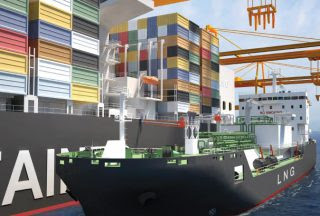The number of LNG bunkering vessels has grown
from one at the beginning of 2017 to six in early 2018, with these numbers
expected at least to double by 2020, multi-sector industry
coalition SEALNG said.
from one at the beginning of 2017 to six in early 2018, with these numbers
expected at least to double by 2020, multi-sector industry
coalition SEALNG said.
Furthermore, it is forecast that in the next five years 30
LNG bunker vessels could be operating worldwide.
LNG bunker vessels could be operating worldwide.
Furthermore, it is forecast that in the next five years 30
LNG bunker vessels could be operating worldwide.
LNG bunker vessels could be operating worldwide.
” The bulk LNG infrastructure
is largely built, what remains is the last mile, in which the industry is
showing a growing appetite to invest,”Peter Keller, SEALNG Chairman,
said.
is largely built, what remains is the last mile, in which the industry is
showing a growing appetite to invest,”Peter Keller, SEALNG Chairman,
said.
The interest in LNG as marine fuel is growing especially ahead of
the entrance into force of IMO’s 2020 global sulphur cap.
the entrance into force of IMO’s 2020 global sulphur cap.
“To effectively incentivise the
developments needed to realise a competitive global LNG value chain for cleaner
maritime shipping by 2020, we need to make the credible, fact-based case for
LNG as a marine fuel to the shipping industry – which includes investors,
bankers, shipping lines, bunkering companies, ports, and other enabling
stakeholders such as shippers, governments, regulators, and local communities,” Keller
added.
developments needed to realise a competitive global LNG value chain for cleaner
maritime shipping by 2020, we need to make the credible, fact-based case for
LNG as a marine fuel to the shipping industry – which includes investors,
bankers, shipping lines, bunkering companies, ports, and other enabling
stakeholders such as shippers, governments, regulators, and local communities,” Keller
added.
“Second, we need to develop
content and data that decision makers can use as they evaluate future fuel
alternatives and make decisions. The industry continues to require credible,
fact-based material, backed-up by academic research as necessary, on the
emissions, investment and infrastructure case for LNG.”
content and data that decision makers can use as they evaluate future fuel
alternatives and make decisions. The industry continues to require credible,
fact-based material, backed-up by academic research as necessary, on the
emissions, investment and infrastructure case for LNG.”
LNG eliminates both SOx and PM emissions and reduces NOx by
up to 90 pct. However, important questions relating to the global warming
implications of methane emissions in natural gas production and transportation
as well as methane slippage in marine engines remain.
up to 90 pct. However, important questions relating to the global warming
implications of methane emissions in natural gas production and transportation
as well as methane slippage in marine engines remain.
SEA/LNG said it was working on bringing clarity on the investment
in LNG by providing shipping lines with an analysis of the qualitative
factors that should help to inform them on new build investment decisions. What
is more, data is being developed on the available and planned LNG
infrastructure to support shipowners’ plans to invest in LNG.
in LNG by providing shipping lines with an analysis of the qualitative
factors that should help to inform them on new build investment decisions. What
is more, data is being developed on the available and planned LNG
infrastructure to support shipowners’ plans to invest in LNG.
The association believes that once the fact base is set out
in a clear and credible manner for the global shipping industry, LNG will move
from the ‘chicken and egg’ to the implementation phase.
in a clear and credible manner for the global shipping industry, LNG will move
from the ‘chicken and egg’ to the implementation phase.
World Maritime News.

